


In a footnote for his writing down of his own dream, Lovecraft then finished with the suggestion "Add good development & describe nature of bas-relief" to himself for future reference. Lovecraft then used this for a brief synopsis of a new story outlined in his own Commonplace Book at first in August 1925, which developed organically out of the idea of what the bas-relief in the dream actually might have depicted. It is new, indeed, for I made it last night in a dream of strange cities and dreams are older than brooding Tyre or the contemplative Sphinx, or garden-girdled Babylon. This can be compared to what the character of Henry Anthony Wilcox tells the main character's uncle while showing him his sculpted bas-relief for help in reading hieroglyphs on it which came through Wilcox's own fantastical dreams: Why do you say that this thing is new? The dreams of men are older than brooding Egypt or the contemplative Sphinx, or garden-girdled Babylon, and this was fashioned in my dreams. Lovecraft then remembers himself answering the curator with the response The curator initially scoffs at him for trying to sell something recently made to a museum of antique objects. In the dream, Lovecraft is visiting an antiquity museum in Providence, attempting to convince the aged curator there to buy an odd bas-relief Lovecraft himself had sculpted. The first seed of the story's first chapter The Horror in Clay came from one of Lovecraft's own dreams he had in 1919, which he described briefly in two different letters sent to his friend Rheinhart Kleiner on May 21 and December 14, 1920.


 0 kommentar(er)
0 kommentar(er)
